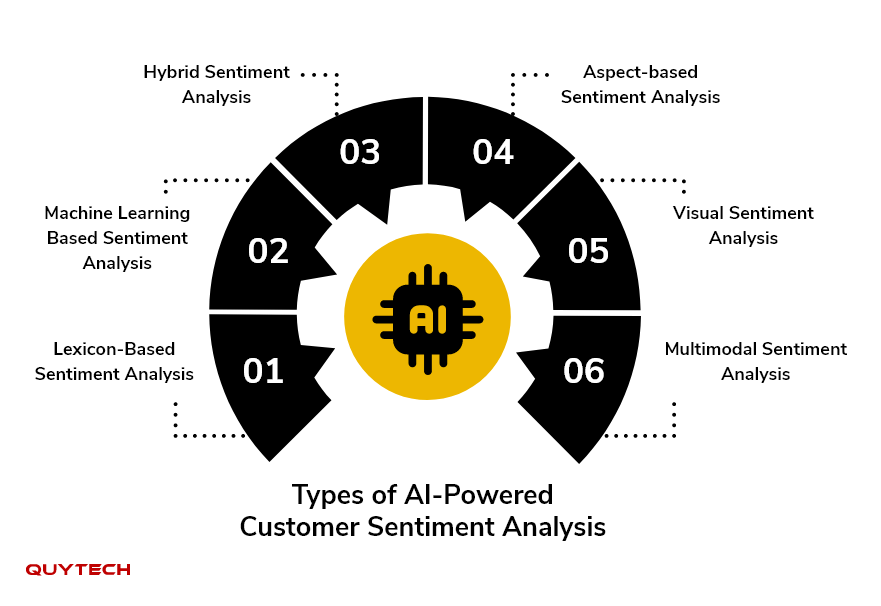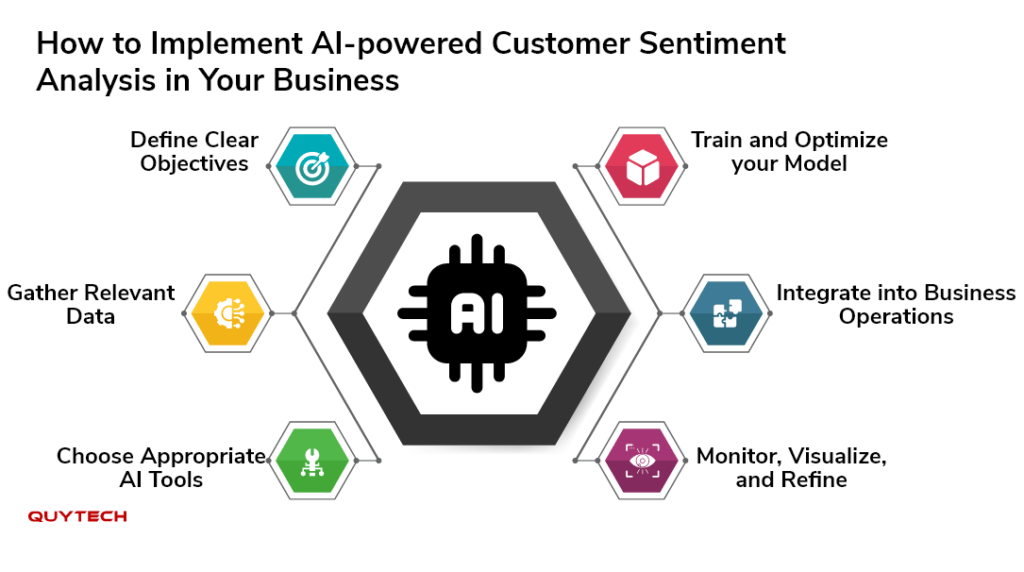Today’s customers don’t just write their sentiments; they express them in different ways. The expression of satisfaction or dissatisfaction is no longer tied to simply writing good or bad in the review sections, but is now openly expressed in audio, video, and live feedback.
Multiple people, multiple thoughts, and mixed emotions, all these can be hard to understand simply through words. This is where AI plays its role in customer sentiment analysis. It analyzes the sentiments of customers by detecting their moods, emotions, audio, visual, and intent.
With this guide, discover the world of AI-based customer sentiment analysis and learn how it’s transforming customer insights into actionable strategies.
What is Customer Sentiment Analysis?
Customer sentiment analysis is a process that works by identifying and interpreting the emotions of the customers. Sentiment analysis helps a company determine customer satisfaction with the product or service provided to them.
The traditional customer sentiment analysis system heavily depended on text-based reviews only. Later, the AI-assisted sentiment analysis models set a new track by analysing the sentiments more efficiently by interpreting the data with the assistance of AI.
This approach did save a lot of time and effort, but still lacked what was needed to understand the customers more effectively. This void is now filled with advanced AI-powered customer sentiment analysis, which effectively understands the emotions and visual reactions of customers to identify their level of satisfaction.
What is AI-powered Customer Sentiment Analysis?
AI-powered customer sentiment analysis represents a step forward from existing AI-assisted models. The AI-powered customer sentiment analysis model identifies and interprets everything from a little detail to big reactions made by customers to understand their feedback. It not only analyzes but also guides on how to act on those intents in real time.
It makes use of natural language processing, machine learning, speech emotion recognition, and computer vision to analyse and interpret the emotions, reactions, and attitudes. It does this across multiple channels like audio, video, facial expressions, etc.
The technology used to develop an AI-powered customer sentiment analysis enables it to detect real-time changes. Unlike the traditional analysis, this does not distinguish between ratings and reviews but goes beyond that. It detects the tone and judges the intent of the customer. It can analyze facial expressions and gestures be it in video feedback or real-time interaction. It is built in a way that it identifies emotion-rich phrases and sarcasm easily without giving inaccurate results.
AI in Customer Sentiment Analysis: Market Stats
- As per IDC, the growth rate of multimodal analysis (text, audio, and video) is 17.5% CAGR.
- As per McKinsey, AI-powered sentiment analysis channels serve to enhance the customer experience through real-time speech analysis.
- According to Qualitrics, 36% of customers are dissatisfied with the level of empathy displayed throughout their encounters with customer support representatives.
Read More: AI in CRM: Transforming the Customer Relationship Management
Types of AI-Powered Customer Sentiment Analysis
As customer expectations continue to rise, businesses have adopted different approaches to customer sentiment analysis. The following are the approaches to customer sentiment analysis:

Lexicon-Based Sentiment Analysis:
The lexicon-based approach works by setting a predefined dictionary or lexicons. In this analysis, the feedback is compared to the lexicons and then analyzed based on the match.
Machine Learning-Based Sentiment Analysis
efewfedwqdewdefThis approach works by labelling data and then analyzing the feedback based on the features extracted from the training data. In this analysis, the machine is trained in a certain manner to detect if the feedback is positive or negative.
Hybrid Sentiment Analysis
The hybrid approach is a combination of both the lexicon and the machine learning approach of sentiment analysis. It uses the lexicon approach to identify the initial cues in the feedback and then the machine learning approach for validation.
Aspect-based Sentiment Analysis
In the aspect-based approach, the feedback is classified based on specific aspects. It does not work on providing a general sentiment analysis, but for the specific features of a product or service.
Visual Sentiment Analysis
The visual sentiment analysis works on determining the nature of the feedback expressed in images and videos. It makes use of computer vision and pre-trained models to detect common sentiments like joy, anger, sadness, etc.
Multimodal Sentiment Analysis
The multimodal sentiment analysis works by integrating multiple types of data, like images, sound, videos, texts, etc., to determine the emotion and intent from the feedback. It tracks textual feedback, video emotions, reactions, and gestures through its multimodal fusion architectures.
Benefits of AI in Customer Sentiment Analysis
AI plays an important role in customer sentiment analysis and helps a business gain a competitive advantage. The following are the advantages of AI in Customer Sentiment Analysis:
Enhances Customer Experience
AI assists in determining the sentiments of the customer in real-time while they interact. This helps in knowing the emotions and reactions of the customer when they talk about the product or service.
Handles Large Volumes of Feedback Quickly
AI can easily handle a large amount of feedback without affecting the quality of the analysis. This enables businesses to identify a broad range of emotional trends in a very short amount of time, enhancing operational efficiency.
Detailed Aspect-Based Insights
The role of Artificial Intelligence is very significant as it does not just provide a broad view of the feedback, but also provides aspect-based opinions of the customers. This helps a business to identify the improvement points in its product or service.
Works Across Multiple Languages
AI enables the sentiment analysis system to seamlessly work across platforms as well as languages. This helps in targeting a global customer base and collecting accurate feedback with the right consistency.
Understands More than Just Emotions
Artificial Intelligence helps in detecting more than just an emotion. It helps in identifying the thoughts, reactions, gestures, tone, facial expressions, etc. This helps in improving the quality of sentiment analysis.
Assists in Informed Decision Making
AI assists in guiding the business towards the right direction and making product or service-related decisions based on the feedback acquired. This empowers businesses to act proactively instead of reactively.
Learns and Improves with Time
AI models learn and improve with time through the new data they collect and analyse. This helps businesses in a very prominent way as they don’t have to keep feeding data into the model. It will automatically learn and adapt to the dynamics.
Read More: How AI-Powered Chatbots Improve Customer Service in Retail?
How to Implement AI-powered Customer Sentiment Analysis in Your Business
The role of AI in Customer Sentiment Analysis enables a business to move beyond generic feedback and adopt a technologically backed sentiment analysis system. The following steps can help implement AI-powered Customer Sentiment Analysis in your business:

Define Clear Objectives
Start with a clear purpose behind the implementation. Whether it is to reduce customer churn, improve customer experience, or determine brand perception, define the purpose clearly to form the right track.
Gather Relevant Data
Gather the relevant data from different sources in textual form. The data gathered should be diverse and from different platforms, like review platforms, chatbot logs, social media, etc. Follow data privacy to stay compliant.
Choose Appropriate AI Tools
Choosing the appropriate tools can be done by either using the existing tools, like AWS Comprehend, or by building your custom AI model. The second option may take more time and effort, but gives better results.
Train and Optimize Your Model
Train your model with labeled data specific to your domain. Utilize techniques like transfer learning and continual fine-tuning so that the model keeps improving with time. This will help in keeping up to date with the evolving language.
Integrate into Business Operations
Integrate the AI-powered sentiment analysis into workflows. Utilize it in customer relationship management and marketing tools. This will help in guiding support responses and tailoring campaigns.
Monitor, Visualize, and Refine
Use tools to analyze sentiment trends across time, regions, and products. This will help teams identify customer moods & preferences and spot problems actively. Regularly refine the sentiment model to keep it updated with the market dynamics.
Hiring skilled AI developers can help you realize your vision with assurance and effectiveness if creating an AI-powered consumer sentiment analysis system seems difficult or resource-intensive.
Real-World Examples of AI-Powered Customer Sentiment Analysis
In today’s customer-oriented business world, understanding the image of your product, service, or brand plays a vital role. AI-powered customer sentiment analysis is a medium through which businesses can connect directly with the thought process of the customers. It helps businesses to act based on feedback obtained from customers and improve customer satisfaction.
Many proactive businesses use artificial intelligence-powered sentiment analysis to gain a better understanding of customer satisfaction and experience. Here are some real-world examples of businesses that make use of AI in customer sentiment analysis:
E-commerce
Amazon utilizes Artificial Intelligence in customer sentiment analysis to extract sentiment from large-scale feedback. This helps its customer base while making any purchase decision with the help of already analysed positive and negative aspects of the product.
Automotive
To identify patterns in consumer mood and behavior, Widewail’s 2023 Voice of the Customer Report utilized AI-powered customer sentiment analysis and examined more than 1.5 million Google reviews from more than 16,000 new car dealerships.
Healthcare
The Cleveland Clinic, a well-known healthcare organization, uses AI customer sentiment analysis to evaluate patient ratings and comments. This helps them to uncover patient care areas and improve management, and provide better facilities.
Entertainment
Netflix processes user reviews and social media mentions for its original content using artificial intelligence sentiment analysis. This helps it to make informed judgments about what content to create or scale in the future.
Hospitality
Marriott International processes and examines guest feedback from its 7,000+ locations using artificial intelligence. Through this, they can rapidly identify areas for improvement, like as amenity quality, staff friendliness, or room cleanliness, by analyzing evaluations to find recurring themes and sentiments.
Multifamily
Widewail’s AI-based sentiment analysis provided multifamily operators with comprehensive knowledge of residents’ priorities. This enabled data-driven choices to enhance the residents’ experience while boosting retention rates and the facility’s reputation.
How Quytech Can Help You Build AI-Based Customer Sentiment Analysis Software for Your Business
Quytech offers end-to-end development of AI-based customer sentiment analysis software tailored to your business needs. With years of experience and expertise in AI and Machine Learning, our team of engineers provides you with the best solution.
Our AI experts specialize in developing the AI-powered sentiment analysis system that performs exceptionally and aligns with your business idea and goals. We provide you with a specialized team of experts who excel at building domain-specific AI models for sentiment analysis.
The Artificial Intelligence-backed sentiment analysis puts your company in a position to stay ahead of the competition in an experience-driven market. It assists in making data-driven decisions and comprehending customer behavior better.
Conclusion
AI customer sentiment analysis is a futuristic step in knowing your customers better. Backed with advanced computer recognition algorithms, natural language processing, machine learning, and speech emotion recognition, the AI customer sentiment analysis accurately judges customers’ sentiments.
With multiple benefits like enhanced customer satisfaction, aspect-based insights, scalable solutions, and continuous improvement, this segment not only caters to customers perfectly but also helps businesses in gaining a competitive edge.
FAQ’s
Yes, an AI-powered customer sentiment analysis gives accurate results when it is trained with domain-specific data. It develops and learns with time, and keeps improving the accuracy thereafter.
AI-based customer sentiment analysis systems can detect sarcasm or irony as it is developed with deep learning models. The large datasets used in training these models include sarcasm, irony, and even slang.
Yes, the AI-powered sentiment analysis works in real time by giving accurate judgments. It does so by utilizing NLP, speech emotion recognition, multimodal approaches, and computer vision.
Yes, small businesses can also benefit from AI-based customer sentiment analysis. They can use it to judge brand image, customer experience, and satisfaction to make better decisions.



